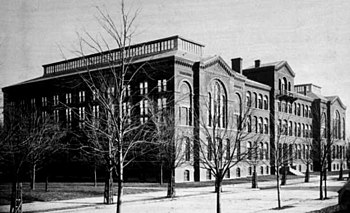Founded by U.S. Army Brigadier General George Miller Sternberg, MD in 1893, the Army Medical School (AMS) was by some reckonings the world's first school of public health and preventive medicine. (The other institution vying for this distinction is the Johns Hopkins School of Public Health (1916).) The AMS ultimately became the Army Medical Center (1923), then the Walter Reed Army Institute of Research (1953).

History
editSternberg created the Army Medical School by issuing "General Order 51" on June 24, 1893. The School was housed, along with the Army Medical Library in the building of the Army Medical Museum and Library (affectionately known as the "Old Pickle Factory" or "Old Red") at 7th Street and South B Street (now Independence Avenue), SW, Washington, D.C. (This site is on the National Mall where the Smithsonian's Hirshhorn Museum now stands.)
In 1910, the AMS relocated to 721 13th Street, NW and in 1916 to 604 Louisiana Avenue.
In 1923, the "Army Medical Center" (AMC) was created when (1) the AMS became the "Medical Department Professional Service School" (MDPSS) and (2) the MDPSS moved into "Building #40" on the grounds of the Walter Reed General Hospital (WRGH) in northern Washington, D.C.
The historic edifice known as Building #40 was constructed at 14th and Dahlia Streets beginning in 1922 and reached completion in 1932. This facility consists of four "Pavilions":
- The North or "Vedder Pavilion" (named for Col. Edward Bright Vedder (1878-1952) who established polished rice extract as the proper treatment for beri-beri);
- The South or "Craig Pavilion" (named for Col. Charles Franklin Craig (1872-1950) who in the Philippines proved (1907; with Percy M. Ashburn) dengue to be a filterable agent (virus) and later showed the mosquito Aedes aegypti responsible for dengue transmission);
- The East or "Sternberg Pavilion" (named for Gen. Sternberg (1838-1915), the U.S. Army Surgeon General and co-discoverer of the pneumococcus, known as the "Father of American Bacteriology");
- The West or "Siler Pavilion" (named for Col. Joseph Franklin Siler (1875-1960), who in 1925 first injected dengue virus in serum into humans producing disease and "closing the loop" on dengue transmissibility).
In 1947, the MDPSS became the "Army Medical Department Research and Graduate School" (AMDRGS), which in turn became the "Army Medical Service Graduate School" (AMSGS) in 1950.
In September 1951, "General Order Number 8" combined the WRGH & AMC into the present-day Walter Reed Army Medical Center (WRAMC). Three years later, the research elements of this facility became the present-day Walter Reed Army Institute of Research (WRAIR).
List of presidents and commandants
edit| President | Tenure | Ref(s) | |
|---|---|---|---|
| Col. Charles Henry Alden | 1893 | 1898 | [1] |
| CLOSED DURING SPANISH-AMERICAN WAR | 1898 | 1901 | |
| Col. William Henry Forwood | 1901 | 1902 | |
| Brig. Gen. Calvin DeWitt | 1902 | 1903 | |
| Col. Charles Lawrence Heizmann | 1903 | 1906 | |
| Col. Valery Havard | 1906 | 1909 | |
| Col. Louis Anatole LaGarde | 1909 | 1912 | |
| Col. Charles Richard | 1912 | 1915 | |
| Brig. Gen. William Hempel Arthur | 1915 | 1918 | |
| Col. Weston Percival Chamberlain | 1918 | 1918 | |
| Brig. Gen. Francis Anderson Winter | 1918 | 1919 | |
| Brig. Gen. Walter Drew McCaw | 1919 | 1923 | |
| Col. Weston Percival Chamberlain | 1923 | 1924 | |
| Brig. Gen. Henry Clay Fisher | 1924 | 1929 | |
| Col. Christopher Clark Collins | 1929 | 1930 | |
| Col. Charles Franklin Craig | 1930 | 1931 | |
| Col. Jay Ralph Shook | 1931 | 1931 | |
| Col. Edward Bright Vedder | 1931 | 1932 | |
| Col. Philip Weatherly Huntington | 1932 | 1935 | |
| Col. Joseph Franklin Siler | 1935 | 1939 | |
| Col. George Russell Callender | 1940 | 1946 | |
| Rufus Holt | 1946 | 1949 | |
| Elbert De Coursey | 1949 | 1950 | |
| William S. Stone | 1950 | 1953 | |
See also
editBuildings
editNotable people associated with the AMS and AMC
editGraduates:
- Brig. Gen. Carl Rogers Darnall ('97), also Professor of Chemistry, Center Commander, developed (1910) chlorination of drinking water
- Brig. Gen. Roger Brooke ('02)
Others:
- Brig. Gen. George Miller Sternberg
- Major Walter Reed
- Colonel Edward Bright Vedder
- Charles Franklin Craig
- Colonel Joseph Franklin Siler
- Frederick F. Russell
- Maurice Hilleman, famed vaccinologist, Chief of Dept of Respiratory Diseases (1948–57)
- Brig. Gen. Russell Callendar, Commandant when the tropical medicine course was created in 1941
- Colonel George W. Hunter III, faculty of the Tropical and Military Medicine Course, author of Manual of Tropical Medicine (now Hunter's Tropical Medicine)
- Captain Daniel Carleton Gajdusek, later a Nobel Prize winner (and child molester); assigned to AMSGS (1951–53).
References
edit- ^ Borden's dream: The Walter Reed Army Medical Center in Washington, DC. Government Printing Office. 1952. ISBN 9780160869518.